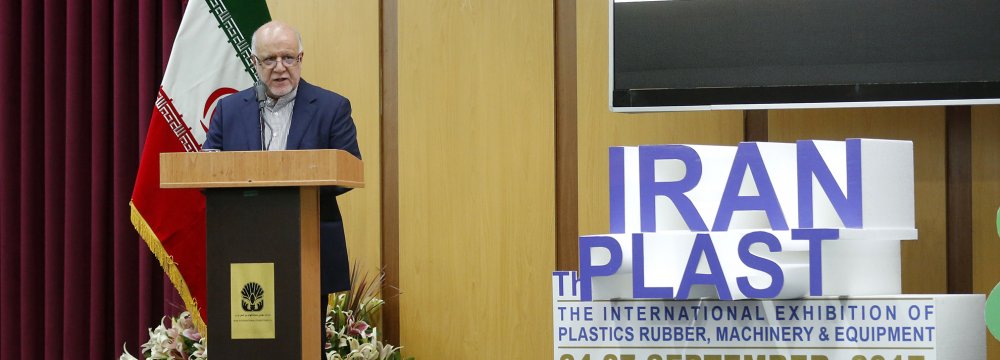
Iran's Annual Petrochem Revenues Seen Reaching $40b by 2022

After opening the country's biggest annual show for petrochemicals and plastics, known as Iran Plast, Oil Minister Bijan Namdar Zanganeh said the value of petrochemical output is expected to reach $40 billion per year by 2022, the end of the nation's Sixth Five-Year Economic Development Plan, IRNA reported.
He said the target is within reach, as new petrochemical plants come on stream.
"Last year, we had promised the launch of new petrochemical plants, including those in Kurdestan and Urmia (West Azarbaijan Province) which are now up and running," he said.
Zanganeh said raising feedstock supply to petrochemical complexes by 1 million tons by the end of the current fiscal year in March, the same as last year, will ensure that petrochemical complexes will be running at near to full operating capacity.
Nominal petrochemical output capacity is set to reach 72 million tons with output forecast to hit the 60-million-ton mark from just above 50 million tons in the previous fiscal.
The southern city of Asalouyeh in Bushehr Province–home to Iran's largest petrochemical plants–is poised for new expansions that could accommodate ventures by western energy giants such as France's Total and Royal Dutch Shell.
"An area of 20,000 hectares (20 square kilometers) is pinpointed in western Asalouyeh for new petrochemical projects," Zanganeh said on Sunday without elaboration.
Marzieh Shahdaei, the head of National Petrochemical Company, said the production of polymers is to reach 12 million tons annually in five years compared to the present 7 million tons.
Iranian industries consumed about 4 million tons of polymers in the previous fiscal, mostly polyethylene and propylene that serve as the building block for packaging material, containers, electrical appliances and kitchenware.
The exhibition, which will run through September 27 at Tehran's International Permanent Fairground, is hosting over 1,100 domestic and international companies, including from Italy, Germany, Spain, Britain, Turkey, China, Japan and India.
The show is an effort to "improve the business environment" for domestic petrochemical and plastic producers, according to a statement on Iran Plast's official website.
New Investments
First Vice-President Es'haq Jahangiri, who also attended the Iran Plast opening ceremony, said the government is pushing to develop the entire chain of the petroleum industry and bring back multinationals to Iran's lucrative energy market.
Jahangiri pointed to investment in upstream exploration and production sectors, as well as joint [oil and gas] fields, collaboration with foreign firms and finalizing a contractual framework as the government's top priorities.
"Downstream petrochemical sector is an important avenue for investment," he said, adding that the petrochemical sector has been on the receiving end of $14 billion worth of direct investments after the nuclear deal with the world powers came into force in January 2016.
Holding some of the world's largest hydrocarbon reserves, oil and gas revenues have been a deeply entrenched element of Iran's economy in the last four decades. However, the government is on a mission to diversify the economy and the petrochemical industry is poised to play a leading role to that end.
Iran holds less than 25% of the Middle East's petrochemical market despite holding the world's second largest gas and fourth largest crude oil reserves, according to government data.


Trump weighs using $2 billion in CHIPS Act funding for critical minerals

Codelco cuts 2025 copper forecast after El Teniente mine collapse

Electra converts debt, launches $30M raise to jumpstart stalled cobalt refinery

Barrick’s Reko Diq in line for $410M ADB backing

Abcourt readies Sleeping Giant mill to pour first gold since 2014

Nevada army depot to serve as base for first US strategic minerals stockpile

SQM boosts lithium supply plans as prices flick higher

Viridis unveils 200Mt initial reserve for Brazil rare earth project

Tailings could meet much of US critical mineral demand – study

Kyrgyzstan kicks off underground gold mining at Kumtor

Kyrgyzstan kicks off underground gold mining at Kumtor

KoBold Metals granted lithium exploration rights in Congo

Freeport Indonesia to wrap up Gresik plant repairs by early September

Energy Fuels soars on Vulcan Elements partnership

Northern Dynasty sticks to proposal in battle to lift Pebble mine veto

Giustra-backed mining firm teams up with informal miners in Colombia

Critical Metals signs agreement to supply rare earth to US government-funded facility

China extends rare earth controls to imported material

Galan Lithium proceeds with $13M financing for Argentina project

Kyrgyzstan kicks off underground gold mining at Kumtor

Freeport Indonesia to wrap up Gresik plant repairs by early September

Energy Fuels soars on Vulcan Elements partnership

Northern Dynasty sticks to proposal in battle to lift Pebble mine veto

Giustra-backed mining firm teams up with informal miners in Colombia

Critical Metals signs agreement to supply rare earth to US government-funded facility

China extends rare earth controls to imported material

Galan Lithium proceeds with $13M financing for Argentina project

Silver price touches $39 as market weighs rate cut outlook

















